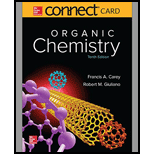
Concept explainers
Interpretation:
An efficient synthesis of pheromone
Concept Introduction:
Alochol on oxidation yields a carbonyl compound. The resulting carbonyl compound is an aldehyde,
A primary alcohol is oxidized to a carbonyl compound containing an aldehyde group.
A secondary alcohol is oxidized to a carbonyl compound containing a keto group.
Pyridinium chlorochromate (PCC) in dichloromethane, pyridinium dichromate (PDC) in dichloromethane are used in oxidizing primary and secondary alcohol to carbonyl compounds.
Phosphorous tribromide converts alcohols to alkyl bromides.
Want to see the full answer?
Check out a sample textbook solution
Chapter 16 Solutions
Connect Access Card Two Year for Organic Chemistry
- Aldehydes and ketones react with one molecule of an alcohol to form compounds called hemiacetals, in which there is one hydroxyl group and one ether-like group. Reaction of a hemiacetal with a second molecule of alcohol gives an acetal and a molecule of water. We study this reaction in Chapter 16. Draw structural formulas for the hemiacetal and acetal formed from these reagents. The stoichiometry of each reaction is given in the problem.arrow_forwardFollowing is the structural formula of the tranquilizer meparfynol (Oblivon). Propose a synthesis for this compound starting with acetylene and a ketone. (Notice the -yn- and -ol in the chemical name of this compound, indicating that it contains alkyne and hydroxyl functional groups.)arrow_forwardThree isomeric pentanols with unbranched carbon chains exist. Which of these isomers, upon dehydration at 180C, yields only 1-pentene as a product?arrow_forward
- Starting with acetylene and ethylene oxide as the only sources of carbon atoms, show how to prepare the compound Q.)1,6-Hexanediolarrow_forwardA synthetic organic molecule, G, which contains both aldehyde and ether functional groups, is subjected to a series of reactions in a multi-step synthesis pathway. In the first step, G undergoes a Wittig reaction, leading to the formation of an alkene, H. Subsequently, H is treated with an ozone (O3) reagent followed by a reducing agent in an ozonolysis reaction, resulting in the formation of two different products, I and J. Considering the functional groups present in G and the nature of the reactions involved, what are the most probable structures or functional groups present in products I and J? A. I contains a carboxylic acid group, and J contains an aldehyde group. B. I contains a ketone group, and J contains an alcohol group. C. I and J both contain aldehyde groups. D. I contains an ester group, and J contains a ketone group. Don't use chat gpt.arrow_forwardWrite the chemical equation showing reactants, products and catalysts needed (if any) for thefollowing reactions. Write the IUPAC name of the product right beside the structure. a) Reaction of two phenol b) Reaction of 2-bromophenol with sodium hydroxide c) Reaction of potassium phenoxide with 2-chloropentane d) Reaction of isopropyl propyl ether with HBr e) Reaction of 3-methylpentan-3-ol with sulfuric acid f) Dehydration of 1,5-hepta-diolg) Oxidation of 1-decanolh) Hydration od hepta-2,3-dienearrow_forward
- Propose a synthesis for the following compounds. As starting materials, you may use cyclopentanol, alcohols containing no more than four carbon atoms, and any reagents and solvents. Trans-cyclopentane-1,2-diol.arrow_forwardIn an advanced synthetic chemistry experiment, a researcher prepares a compound, ZY-7, by reacting a ketone (C5H10O) with hydroxylamine (NH2OH), followed by heating in the presence of an acid catalyst. The resulting compound, ZY-7, is then treated with a solution of sodium nitrite (NaNO2) and hydrochloric acid (HCl) at low temperature. Identify the class of compound that ZY-7 most likely belongs to after this series of reactions." A) Amide B) Oxime C) Nitro compound D) Diazonium salt E) Ester Don't use chatgpt please provide valuable answerarrow_forwardMethyl benzoate was exposed to a nitration test, although it was difficult to see the formation of a fragrant yellow solution. What produced this consequence?arrow_forward
- In the reactions involving 1-butanol, 2-butanol and 2-methyl-2-propanol with the formula C4H9OHdescribe what each of the following tests showed about the reactivity of the -OH group and reactions of 1°,2°, and 3° alcohols. The test with neutral KMnO4 The test with concentrated HClarrow_forwardWrite structural formulas for all the constitutionally isomeric alcohols of molecular formula C5H12O. Assign a substitutive and a functional class name to each one, and specify whether it is a primary, secondary, or tertiary alcohol.arrow_forward1-Phenyl-2-butanol is used in perfumery. Show how to synthesize this alcohol from bromobenzene, 1-butene, and any necessary inorganic reagents.arrow_forward
 Organic ChemistryChemistryISBN:9781305580350Author:William H. Brown, Brent L. Iverson, Eric Anslyn, Christopher S. FootePublisher:Cengage Learning
Organic ChemistryChemistryISBN:9781305580350Author:William H. Brown, Brent L. Iverson, Eric Anslyn, Christopher S. FootePublisher:Cengage Learning General, Organic, and Biological ChemistryChemistryISBN:9781285853918Author:H. Stephen StokerPublisher:Cengage Learning
General, Organic, and Biological ChemistryChemistryISBN:9781285853918Author:H. Stephen StokerPublisher:Cengage Learning Organic And Biological ChemistryChemistryISBN:9781305081079Author:STOKER, H. Stephen (howard Stephen)Publisher:Cengage Learning,
Organic And Biological ChemistryChemistryISBN:9781305081079Author:STOKER, H. Stephen (howard Stephen)Publisher:Cengage Learning,


